Market news & insights
Stay ahead of the markets with expert insights, news, and technical analysis to guide your trading decisions.

Most traders understand EA portfolio balance through the lens of traditional risk management — controlling position sizes, diversifying currency pairs, or limiting exposure per trade.
But in automated trading, balance is about deliberately constructing a portfolio where different strategies complement each other, measuring their collective performance, and actively managing the mix based on those measurements.
The goal is to create a “book” of EAs that can help diversify performance over time, even when individual strategies hit rough patches.
A diversified mix of EAs across timeframes and assets can, in some cases, reduce reliance on any single strategy. This approach reduces dependency on any single EA’s performance, smooths your overall equity curve, and builds resilience across changing market conditions.
It’s about running the right mix, identifying gaps in your coverage, and viewing your automated trading operation as an integrated whole rather than a collection of independent systems.
Basic Evaluation Metrics – Your Start Point
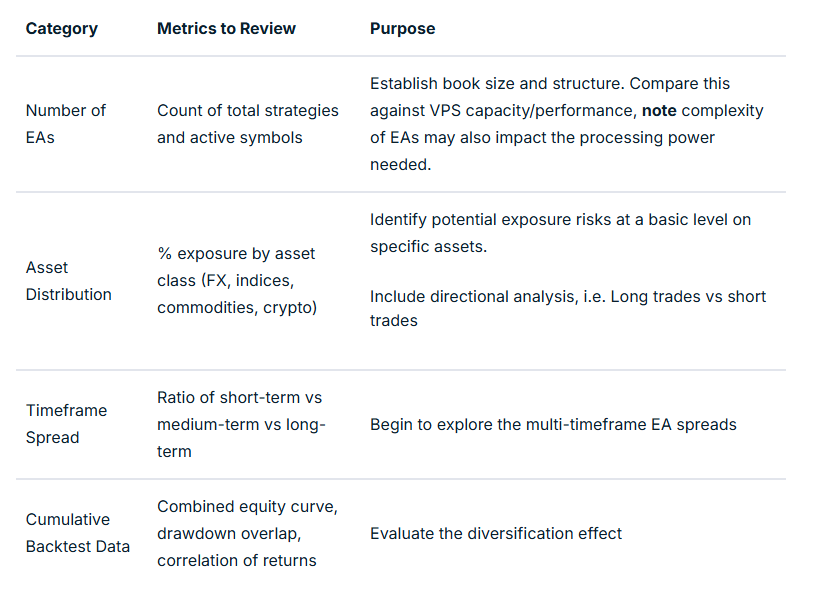
Temporal (timeframe) Balancing
When combined, a timeframe balance (even on the same model and instrument) can help flatten equity swings.
For example, a losing phase in a fast-acting M15 EA can often coincide with a profitable run in an H4 trend model.
Combining this with some market regime and sessional analysis can be beneficial.
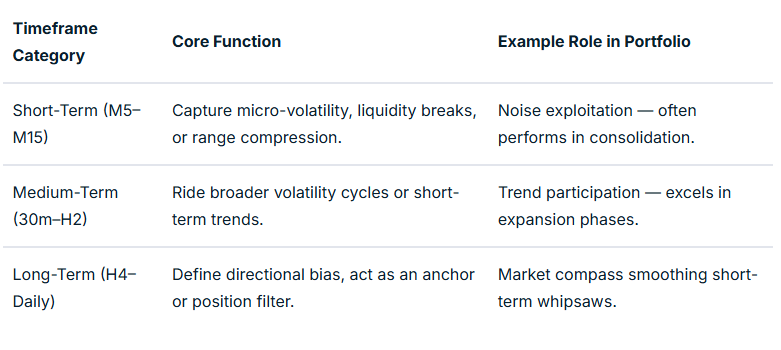
Asset Balance: Managing Systemic Correlation Risk
Running five different EAs on USDJPY might feel diversified if each uses different entry logic, even though they share the same systemic market driver.
But in an EA context, correlation measurement is not necessarily between prices, but between EA returns (equity changes) relating to specific strategies in specific market conditions.
Two EAs on the same symbol might use completely different logic and thus have near-zero correlation.
Conversely, two EAs on a different symbol may feel as though they should offer some balance, but if highly correlated in specific market conditions may not achieve your balancing aim.
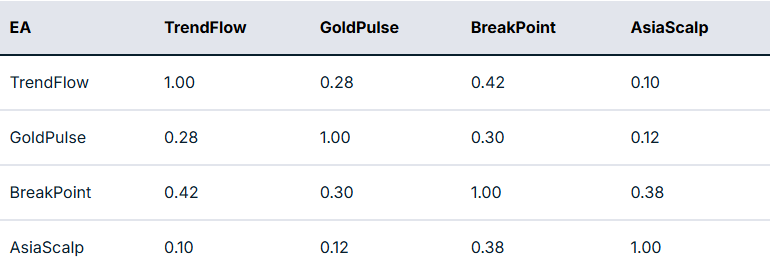
In practical terms, the next step is to take this measurement and map it to potential actionable interventions.
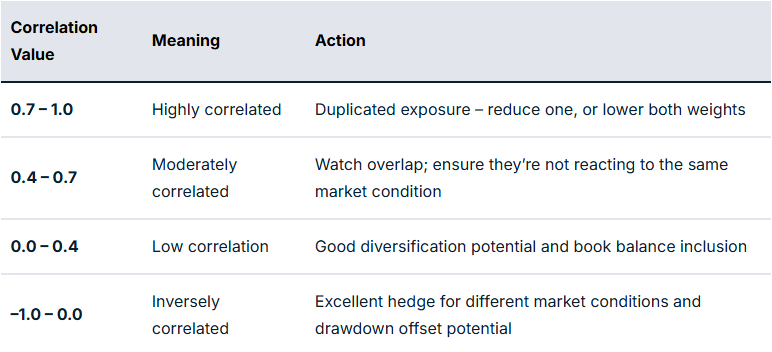
For example, if you have a EURUSD Trend EA and a GBPUSD Breakout EA with a correlation of 0.85, they are behaving like twins in performance related to specific market circumstances. And so you may want to limit exposure to some degree if you are finding that there are many relationships like this.
However, if your gold mean reversion EA correlates 0.25 compared to the rest of your book, this may offer some balance through reducing portfolio drawdown overlap.
Directional and Sentiment Balance
Markets are commonly described as risk-on or risk-off. This bias at any particular time is very likely to impact EA performance, dependent on how well balanced you are to deal with each scenario.
You may have heard the old market cliché of “up the staircase and down the elevator shaft” to describe how prices may move in alternative directions. It does appear that optimisation for each direction, rather than EAs that trade long and short, may offer better outcomes as two separate EAs rather than one catch-all.
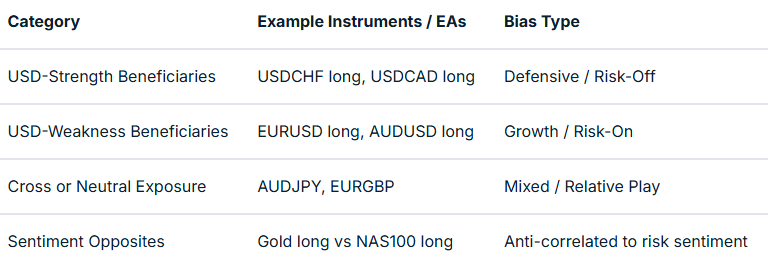
Market Regime and Volatility Balance
Trend and volatility states can have a profound impact on price action, whether as part of a discretionary or EA trading system. Much of this has a direct relationship to time of day, including the nature of individual sessions.
We have a market regime filter that incorporates trend and volatility factors in many EAs to account for this. This can be mapped and tested on a backtest and in a live environment to give evidence of strategy suitability for specific market conditions.
For example, mean reversion strategies may work well in the Asian session but less so in strongly trending markets and the higher volatility of the early part of the US session.
As part of balancing, you are asking questions as to whether you actually have EA strategies suited to different market regimes in place, or are you using these together to optimise book performance?
The table below summarises such an approach of regime vs market mapping:
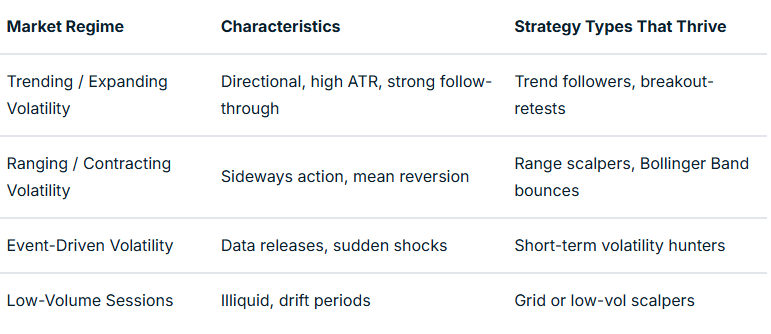
Multi-Level Analysis: From Composition to Interaction
Once your book is structured, the challenge is to turn it into something workable. An additional layer of refinement that turns theory and measurement into something meaningful in action is where any difference will be made.
This “closing the circle” is based on evidence and a true understanding of how your EAs are behaving together. It is the step that takes you to the point where automation can begin to move to the next level.
Mapping relationships with robust and detailed performance evaluation will take time to provide evidence that these are actually making a difference in meeting balancing aims.
To really excel, you should have systems in place that allow ongoing evaluation of the approaches you are using and advise of refinements that may improve things over time.
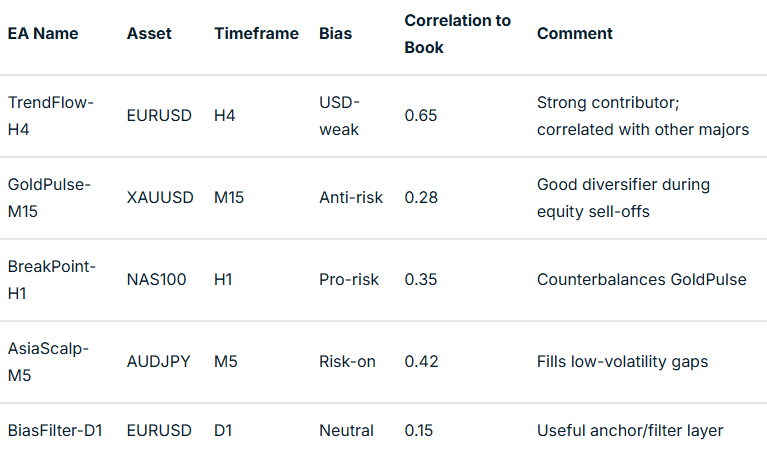
What Next? – Implementing Balance in Practice
Theory must ultimately translate into an executable EA book. A plan of action with landmarks to show progress and maintain motivation is crucial in this approach.
Defining classification tags, setting risk weights, and building monitoring dashboards are all worth consideration.
Advanced EA traders could also consider a supervisory ‘Sentinel’ EA, or ‘mothership’ approach, to enable or disable EAs dynamically based on underlying market metrics and external information integrated into EA coding decision-making.
Final Thoughts
A balanced EA portfolio is not generated by accident; it is well-thought-out, evidence-based and a continuously developing architecture. It is designed to offer improved risk management across your EA portfolio and improved trading outcomes.
Your process begins with mapping your existing strategies by number, asset, and timeframe, then expands into analysing correlations, directional bias, and volatility regimes.
When you reach the stage where one EA’s drawdown is another’s opportunity, you are no longer simply trading models but managing a system of EA systems. To finish, ask yourself the question, “Could this approach contribute to improved outcomes over time?”. If your answer is “yes,” then your mission is clear.
If you are interested in learning more about adding EAs to your trading toolbox, join the new GO EA Programme (coming soon) by contacting [email protected].


IntroductionAs many of you will know, Bitcoin, Ethereum, and an increasingly wide range of other cryptocurrencies have become one of the most closely followed asset classes globally by investors and traders alike. This, combined with the ability to trade these assets using CFDs, has simply added not only to their popularity but also provided you, as a trader, the potential to add something new on top of what you already trade.Its rise to a multi-trillion-dollar asset class has captured the attention of traders, investors, institutions, and even governments, as evidenced by daily updates within mainstream financial media.Crypto's appeal lies not just in its potential for speculative gains, but in its revolutionary structure, which means you are potentially trading a decentralised and borderless asset that operates outside traditional finance. Whether seen as digital gold, an inflation hedge, a future payment system, or simply a volatile trading opportunity, Bitcoin and its peers continue to attract attention.As stated before, more than ever, traders can access Bitcoin and other cryptos easily through a variety of instruments, including crypto CFDs. These allow participation without needing to open dedicated wallets or directly handle tokens, particularly convenient for those already using MetaTrader platforms (MT4/5), where Bitcoin CFDs and other crypto products are increasingly available. GO Markets is leading the way, adding to its crypto offering and as with an asset class, we aim to provide not only the products themselves but also some assistance to those looking at these either for the first time or to expand their exposure into some of the lesser-known cryptocurrency CFDs.As with any new instrument, there are essential things you must know, such as what moves the market, how the product is priced and traded, and how to manage the unique risks that crypto trading brings.On a point of definition, it is worth referencing the term “Altcoin”. This simply comes from combining "alternative" and "coin", and essentially groups together a broad and diverse group of cryptocurrencies with varying functions, technologies, and market purposes.So, whether you're just getting started or reassessing how you trade Bitcoin and crypto, this article aims to provide practical tips, insights into trading system development, and helpful resources to approach crypto markets with more clarity and control.Cryptos versus Crypto ETFs, or Crypto CFDs – Why Trade CFDs?So now onto market issues that may mean CFDs could be for you.Extended Trading Hours: The crypto market on the GO Market MT5 platform is open 24/7, unlike traditional markets, there's no downtime. Trading crypto CFDs lets you access this round-the-clock action without needing to hold the actual coins or use crypto exchanges. Importantly, with CFDs, your trading platform can be your single point of access for not only what instruments you trade already, but you can add crypto CFDs to your toolbox as easily as trading an FX pair or Share CFD.Direct Exposure to Price Action: Unlike ETFs or crypto-themed stocks, which are influenced by broader market factors or business performance, crypto CFDs allow you to trade the price of the asset directly. You’re trading exposure to Bitcoin or Ethereum itself, not a blockchain company's management effectiveness or an ETF's structure.Short and Long with Ease: Crypto CFDs allow you to go long or short easily. For traders looking to take advantage of changes in trader sentiment in EITHER DIRECTION, this is a major advantage of CFDs.Lower Capital Requirements: CFDs offer fractional trading, so you don’t need to buy a full Bitcoin (or even a whole altcoin token). You can start small, even at a 0.1 lot size and scale your position as your strategy begins to show positive outcomes and confidence grows. Your leverage and margin requirement will be dependent on account type, and it is worth emphasising that, as with any margin trading, the risks are exaggerated as well as the opportunity. As with any trading, capital protection and appropriate trade position sizing must remain at the forefront of any trading approach.What Moves the Price of Cryptos?As with gold, which we covered in a recent article, understanding what drives crypto prices helps you trade proactively rather than reactively, with the ability to perhaps see the potential for risks and opportunities early so you can be ready if a set-up or time to exit may be imminent.Before going into the major factors that move cryptos, it is worth briefly looking at the relationship between Bitcoin and altcoins generally, i.e. does a movement in Bitcoin necessarily mean a move in Altcoins?As a rule, most altcoins are positively correlated with Bitcoin (BTC), meaning when BTC goes up, altcoins tend to go up too, and vice versa.There may be a delay in altcoin movement, with BTC leading the way, especially in sharp market moves, although such moves may differ in relative % terms, particularly in lower-cost Altcoins.Additionally, it is worth referencing the potential for changes in specific Altcoins should there be regulatory or protocol-specific news (e.g., an SEC intervention or reports of hacking, for example).It is worth pointing out that some research should be undertaken on individual coin types prior to trading (as arguably you should ALWAYS do with any asset that is new to you).The key factors are as follows:
- Macroeconomic Sentiment: Bitcoin has increasingly behaved as a “risk-on” asset. It tends to rise when confidence returns to markets and fall during macroeconomic fear or liquidity stress. In good economic times, when perhaps investors have more available liquid cash and are happier to speculate, this could be a good time for cryptos. Also, in certain conditions such as increased inflationary concerns, Bitcoin as like gold, may be seen as a potential hedge. These narratives can shift quickly, but being in tune with financial news as well as what you are seeing on a chart may give clues as to how the market is viewing cryptos at any time.
- Regulatory Headlines: As referenced above, Bitcoin and altcoins are highly sensitive to regulation. News from the SEC, European Commission, or Asian regulators can trigger massive market moves as the perception of risk changes. A single statement from a central bank, policymakers or rulings on ETF approval (As we saw with recent increases in crypto ETF offerings) can spark short-term volatility.
- Institutional Adoption and Rejection: Any announcements of crypto being added or removed from payment platforms, ETF funds, or treasury holdings by major companies such as Tesla, BlackRock, or PayPal can sharply influence price in the short term.
- Network Activity and On-Chain Data: Particularly for altcoins, rising transaction volumes, developer activity, and user adoption can signal health and long-term viability. These metrics are often used by crypto-native traders to assess potential.
- Government Sentiment and Narrative: Clearly, and as seen since the inauguration of the recent US change in Government, any change in policy or inferences that regulation may be changed be whether tightened or relaxed, is likely to impact investor sentiment.
5 Practical Steps to Ease into Crypto CFD Trading
- Start with a Demo Account: Just like with gold CFDs, crypto's volatility is real and fast. Use a demo account to observe how Bitcoin or Ethereum behaves during major market sessions and how CFD pricing reflects this.
- Start Small on Live Trades: Begin with minimum lot sizes. Crypto price moves can be significant even on small trades. Slippage, spread widening, and gaps (especially over weekends or during system upgrades) are not uncommon.
- Understand Crypto-Specific Risk: Unlike gold, cryptos are (albeit rarely) vulnerable to hacks, chain outages, and delisting. While less relevant for CFDs, sharp price action can still result from these risks.
- Watch the Clock Differently: Crypto doesn’t sleep, but some hours are more active than others. Overlaps of US and European sessions, as with many asset classes, tend to see higher volumes. Major moves will often happen around US economic data as overall risk-on, risk-off sentiment shifts.
- Evaluate Altcoins Cautiously: If trading lesser-known coins, you need to be aware that these are often more volatile and news-driven. Lower liquidity and more retail speculative exposure can contribute to this, which can, of course, work both positively and negatively on price. Mitigate for this in your trading plan and intra-trade management.
Strategy and Risk Management ConsiderationsDefine Your Strategy: Are you trend-trading based on technical levels or swing-trading based on macro narrative shifts? Crypto, of course, may suit, but trading consistency ALWAYS requires clear entry and exit criteria as well as discipline in the execution of your plan.Adjust for Volatility: Use tools like ATR to set more realistic stops and targets. Bitcoin, for example, can EASILY move 3–5% in a standard day even without a major headline. Your system needs to reflect this.Incorporate Trailing Stops: Once in profit, use volatility-based trailing stops to protect from profit risk. i.e. giving too much back to the market with a successful trade.Use Breakout Confirmation: Altcoins, especially, are prone to false breakouts—often pumped and dumped quickly. Use volume, RSI/MACD divergence, or candle confirmation before acting.Avoid These Common MistakesOverleveraging: The temptation to “bet big” on a small move is real. But the reality of a 10% intraday swing should be enough to convince any trader to manage size carefully, as of course, risks are magnified with leveraged trading as stated previouslyChasing Hype Coins: Many traders lose by buying at the peak of any ‘hype cycle’. If you see price trending for some time or just hit a MASSIVE gain, you could be too late to the party. Have a plan to manage this potential risk.Ignoring Broader Markets: Bitcoin does not exist in a vacuum. Its correlation with Nasdaq, yields, and USD strength is growing. Don't ignore these intermarket relationships.Trading Every Coin You See: Focus on 1–3 cryptos, learn what they are, what specifically moves them and anticipated usual price action. Once you have mastered these them perhaps add one at a time. Random entries based on “this coin might go to the moon”. This is not a strategy, it is a gamble.Summary and Final ThoughtsCrypto CFDs offer exciting opportunities, but they also demand discipline, structure, and adaptability to manage risk effectively. The lessons from other markets still apply, including knowing what moves your market, having an unambiguous plan, and building confidence slowly as you execute both entry and exits.Whether you're trading Bitcoin or branching into altcoins, the goal isn’t just fast profits, but consistent, well-managed decisions over time with consistency in action so you can see what is working and what perhaps isn’t. As with all trading, performance evaluation is critical; only through effectively doing this can you refine what you are doing to move towards the crypto trade you can become.


Introduction: Why Seeing Patterns Alone Is no more than a start pointMany traders begin their journey by being taught and then noticing visual patterns on charts such as a two-bar reversal, a classic triangle, double top or maybe a series of wicks that seem to regularly signal a turning point. These patterns often look compelling, especially when they seem to appear just before a major price move.But here's the catch, once we spot a pattern of interest we subsequently look for it, a little bit of confirmation bias may creep in so we ignore those times it may not work, and so in real terms when looking for positive technically moves at this stage arguably at best it can be described as an interesting chart story rather than a robust strategy,And yet for many, seeing some examples of where things looked exciting appears to be enough to start to trade this idea, more commonly than not, resulting in outcomes which fall short of what we hope they may be.The reality is that unless the pattern can be clearly and unambiguously defined, then tested, and of course applied and reviewed consistently, it is likely to remain in the “may have potential category. “So, encouraging you as a trader to seek out potential repeatable patterns that may be technically interesting, there is a process, a roadmap to turn this idea into something that may prove to be more than this and something that could result in a robust trading strategy,Pattern Recognition vs. Pattern ReliabilityFor humans (and I assume most of you are), pattern recognition is in-built, it is how our brains are wired, and we have an ability to find shapes, rhythms, and familiar sequences. But of course, sometimes markets are unclear, full of noise, and constantly shifting by varying degrees and for an uncertain period. So, what may appear to be a potentially reliable pattern may just be a random formation if not taken to the next level of analysis.Add to that the potential for previously mentioned confirmation bias, and the potential for recency to be viewed as important, e.g. this pattern worked last week”, this compounds the difficulties in turning this into something meaningful. So, without downplaying the merit in further exploration, if you are interested in developing a strategy around this, then we, as traders, must move beyond recognition to verification, creating clarity and measurable criteria not only for set-up but the WHOLE strategy is essential.Define It or Ditch It — The Power of Objective CriteriaIt is worth emphasising that the objective here is to have something that not only gives great results over time but MUST be created in a way that facilitates consistent trading action, only then can you be sure that it is repeatable. The first step in this is to move towards clearly defining your trading setup. You must remove any grey areas, which will appear more so in the heat of the market action. Every part of it needs to be translated into specific rules. To give the critical parts and examples, it could look something like this:
- Entry trigger (e.g., a bullish engulfing candle with increased volume)
- Confirmation filter (e.g., trend direction or volatility band breakout)
- Context filter (e.g., session time or support/resistance proximity)
- Exit condition (e.g., 2:1 reward-to-risk, opposite signal, or time-based)
- Risk management (e.g., fixed fractional, ATR stop, position sizing)
That is the start … but then you must dive deeper, striving for increased objectivity as the more you do so, you are not only enabling you to achieve consistency, but later it is easier to refine SPECIFIC parts that can make things even better.For example, instead of loosely saying, "a bullish engulfing candle," define it as thoroughly as you can with context:
- A candle whose body fully engulfs the previous one on the candle's close
- Appears after three consecutive bearish candles.
- Must close in the top third of the bar range.
- Accompanied by a volume bar higher than the two previous ones.
Now do the same for every other part of your strategy.Now you have not only a setup but more importantly, a roadmap about what to do for EVERY part of the life of the trade. Something that can be traded with absolute consistency, reviewed, and arguably more easily traded with discipline, as in the market, you have absolute clarity and what you are doing and when.Failure Detection OF course, for those interested, there are increasingly sophisticated methods to test your new system. You can turn it into an automated strategy (even if you still intend to trade it on a discretionary basis) and use formal strategy testers or code to run your system on historical data. Fortunately, manual testing is still as effective, but it is worth emphasising a few key points of good practice.The goal of this process is principled observation over sufficient time:
- Observe Across Market ConditionsWatch how your setup performs in different environments. Compare what happens (both when it works and doesn’t work so well) in ranging vs. trending markets, high vs. low volatility, before and after news events.
- Tag and Journal TradesUse a spreadsheet or journal to track setup and full system behaviour. Note the time, direction, context, and whether the trade won or lost. Include tags that can be recorded in columns such as "against trend" or "news overlap" to spot weak periods, as well as the strong ones. This will help refine any filters you are using for entry.
- Track Missed OpportunitiesArguably, it is equally important to not just journal the trades you take. Note the ones you didn’t take also (for whatever reason, e.g. you were sleeping) and treat them as important as any live trades, as they do add to the weight of evidence. (although the latter, of course, adds the extra important variable of being able to track whether you were disciplined in execution). Were you consistent in your application?
- Ask “What Broke It?”When a trade fails, identify why this may have e.g. been it in the setup itself? Is there a filter you could have considered that would avoid similar future events? Was there something in the market that may have given clues?
It is VITAL in your evaluation to remember that a losing trade isn’t necessarily a failed setup. A failed setup does not behave as expected, even when you have applied it correctly.Measuring the Edge – The Numbers are your Friend You don’t need advanced statistics to understand whether your new strategy is likely to hold water or not. These key numbers should not only be your justification for taking your strategy into the market but also the basis for ongoing evaluation to be able to assess and adjust as necessary. Basic metrics can give you a strong signal:
- Win rate: How many trades out of 10 are winners/losers?
- Average R-multiple: Are your winners larger than losers compared to the risk you are taking?
- Results Expectancy: (Win% x Avg Win) - (Loss% x Avg Loss)
- Maximum balance drawdown and trade streaks: How tough is the worst stretch, and how good is your best one, i.e. consecutive wins and losses. When we refer to drawdown, this is from the high point of your equity to its worst pullback, NOT your account start point.
You can build this evaluation process over time, record on a spreadsheet and move to 20-30 trades and beyond. Ask questions of the data you have, and you may start to notice things like:
- What times of day may be good or bad, e.g. market open
- It fails more often in range-bound markets.
- One or two big wins contribute 70% of profits.
And then there is you… So, let’s assume we have neutralised the demons of recency and confirmation bias in our system development and successfully created a system that looks as though it may create some positive trading outcomes going forward. It is then that the major mindset work begins.Even a strong strategy is weakened considerably if it’s not executed well. Many systems fail because traders lack the consistency to quite simply follow the plan.You may find yourself quitting after a small losing streak, overriding the system after a big win (or fear of missing out on something even bigger). Skipping trades due to hesitation or distraction will also impact execution.To make it clear.Without full execution, you can’t measure the success or otherwise of your system or make evidence-based judgements on what could make it even better. So, as close to 100% compliance is always the aim (and if you do stray, you will have to remove those results from an analysis you do, of course).And finally, the great news is that on the other side, having done the hard yards of follow through, and seen positive outcomes, the belief that is created in your system because you have the evidence, is much easier to continue with the discipline you need to.Final thoughts … Repeatability is the Real Edge in Your StrategiesWhat we are trying to achieve in this article is to give you a guide to moving from seeing patterns to making a profit. The only way to stack the odds in your favour and develop what many term “an edge” in your trading is by having and following a process you can trust.There are no shortcuts, but definable steps you must take, through defining your setup and whole strategy, test it, track its behaviour on an ongoing basis, and apply it with discipline, you create something potentially meaningful, and importantly, it is a fit for you as a trader.Yes, there is work, but I hope I have been able to stress the importance and potential benefits of doing the right things from start to finish.


We want to point out some interesting statistics that have us asking, Are we in a blue sky world or a cruel joke?Since the April 7th intraday lows, equities have done some astonishing things. The S&P 500 is now up 22% from that low. On April 8th, the S&P was down 15% year to date, yet it took just 25 trades from that closing low to reverse all that loss. The last time that happened was 1982 – a year the S&P went on to rally hard, and even in the preceding years before smacking into the 1987 bear crash.So are we in the blue sky?Well, currently, global equity markets are showing signs of near-term consolidation, but beneath the surface, a shift in sentiment is underway. The recent de-escalation in global trade tensions, especially from the U.S., is prompting investors to start pricing in this “Blue Sky” scenario in equities; however, it is not materialising in bonds.This is also a faint appearance of a bubble, driven by investor enthusiasm around AI and the potential for looser monetary policy later in the year. Blue Sky thinking does lead to this - markets need this goldilocks scenario and appear to think that is going to be the path rather than the exception.The realistic path is a near-term outlook that remains complex and, in some areas, fragile, in others already breaking.The Cracks While some indicators have improved, others reveal underlying softness.Take earnings revisions and/or lack of guidance altogether. The 4-week moving average for U.S. earnings revisions has seen a modest lift, but that is in no small part due to the weak U.S. dollar. The more significant 13-week moving average tells a different story.This longer-term gauge, both in the U.S. and globally, continues to lag, primarily because it trails the reporting cycle. For now, markets are clinging to hopes of an imminent turnaround in corporate earnings, but the data suggests that’s unlikely in the short run.Adding to the caution, U.S. GDP growth is forecast to slow significantly, dropping from 2% year-over-year in Q1 to less than 1% by Q4. Look at auto sales, currently booming, back the consumer feedback is that this is due to ‘tariff beating’. If that is the case, come Q3 and Q4, there is going to be a collapse in sales as the price increases come in and consumers go on strike.The FedThe Federal Reserve is now expected to stay on hold until September, according to current market pricing, and that is post-the PPI and other inflation input measures that came in lower than expected, leading equities to assume it could be earlier.Yes, the Fed is nearing the end of its tightening cycle, but a cautious tone and concerns of stagflation signal that policy normalisation will be slow, deliberate and data dependent, not sentiment driven or on geopolitics.This measured approach will be a double-edged sword; it will have opportunities for some but also elevate the risk of market volatility around key data releases, including inflation, labour market trends, and consumer spending.Tariff paths of resistance
- Path one: Moderation – consensus has a 50% blanket tariff on Chinese imports to coming into effect post-90 day pause with a 10% sector-specific measures globally – meaning the 25% tariffs on steel and aluminium will be cut to 10% and pharmaceutical which are yet to be hit will have a blanket 10%. This would lead to a moderation of the current buying in equities.
- Path two: This is the more optimistic path. If the recent tariff announcements are primarily negotiating tools rather than enduring policy shifts, markets could reprice upward. A more conciliatory tone on trade, especially ahead of the U.S. mid-term election, could reduce uncertainty and support a rerating of equities, as mentioned, this is what appears to be priced in by equities but not bonds.
- Path three: Bubble, this scenario can’t be dismissed. If investors become overly optimistic, buoyed by AI-driven gains, rate-cut speculation, and financial conditions that loosen too quickly, markets could overshoot fundamentals, reviving concerns of a speculative bubble.
The Good: UpsideSeveral forces could support further upside. Generative AI continues to be a structural driver, both in terms of productivity gains and equity multiples. Inflation is also expected to moderate. Consensus has U.S. inflation falling to 3.9% by year-end, giving the Fed cover to start easing at that September meeting. A fall in inflation, combined with improving real wage growth, could support consumer spending and corporate margins.Wage growth remains a positive offset to macro headwinds. The U.S. voluntary quit rate is still elevated, and wage gains are holding steady around 3.5%. This is helping to stabilise corporate profit margins and close the gap between labour cost growth and productivity.If this dynamic continues, particularly with inflation trending lower, it would strengthen the case for a supportive rate-cutting cycle. All market upsides.The Bad: DownsidesYet risks remain—and they are not trivial.Trade policy remains the most significant near-term overhang. With the U.S. mid-term election on the horizon, the direction of global trade remains unpredictable. Whether tariffs become a core policy plank or merely a short-term lever will shape investor sentiment through the second half of the year.Macro data surprises, particularly around inflation, labour markets, and corporate earnings, could also spark renewed volatility. At the same time, central bank missteps or unexpected geopolitical developments (of which there could be many) could easily upset the fragile equilibrium in markets.The Outlook: Is it ugly?The U.S. is expected to maintain its leadership position, but market breadth is improving. The dominance of a handful of mega-cap names is beginning to fade, and sector rotation is creating new opportunities across geographies and industries. See reactions in Europe and Asia.Meanwhile, AI continues to disrupt the investment landscape. Algorithmic trading, real-time sentiment analysis, and personalised investment models are reshaping how capital is allocated and how fast markets react. This can lead to asymmetrical trading and disparities between fundamentals, technicals and actuals.So it’s a little ugly, but that is the new world.
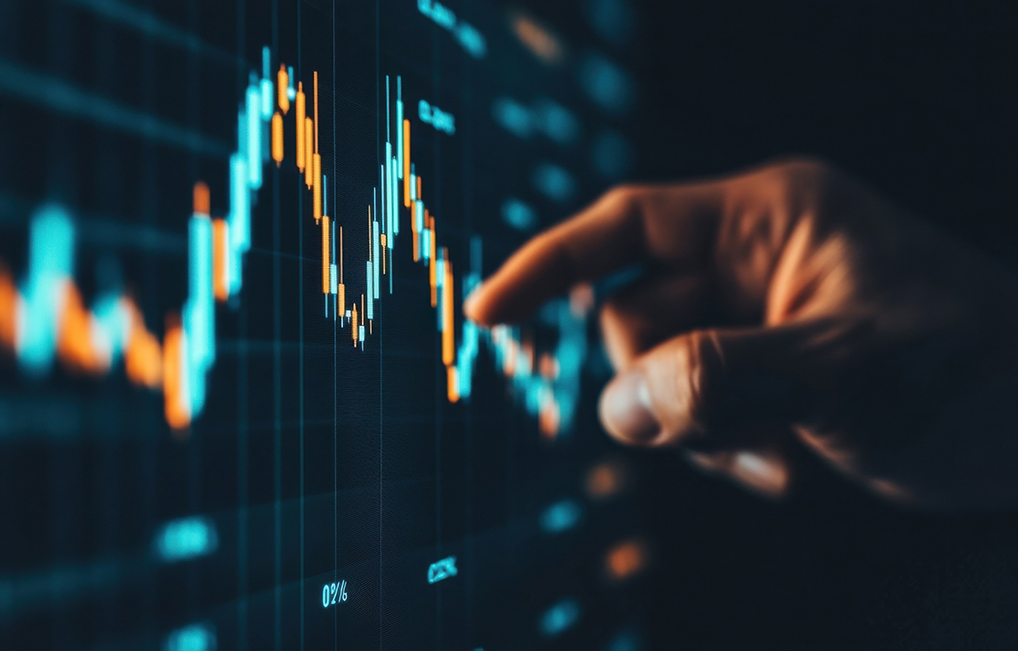

IntroductionThe commonly used approach for those who trade financial markets in developing and implementing strategies often focuses on waiting for confirmation before entering positions. While the approach may help reduce false signals and offer some psychological comfort from confirmation, it may introduce a significant drawback. When a movement has been confirmed through a defined price level, much of the potential profit may have already vanished.Consider this in light of your experience -- how frequently have you entered a trade after a clear signal, only to watch the market immediately reverse or stall? Of course, this is frustrating, but it arguably stems from a fundamental issue with such reactive trading approaches. These can place you behind the curve, rather than ahead of it.This article aims to review the standard reactive approach and explores ways that you may look to develop strategies that anticipate market movements before they materialise fully. This, at least in theory, can put you near the “front of the queue” for any potential move, so logically offering the chance of better entries and so trading outcomes through shifting your focus from confirmation to prediction.Reaction versus Prediction: What's the Difference?The Reactive approachMost trading strategies operate reactively, requiring definitive proof before committing capital to a trading idea. Consider a classic moving average crossover, a simple and commonly taught technical strategy. A trader looks at a chart until the shorter-term moving average crosses above a longer-term average, confirming an uptrend is underway. However, by definition, this signal arrives after momentum and price are already well underway.So, what is happening here is fulfilling an approach that favours certainty over timing. They value confirmation and often enter positions after key levels break or indicators flash clear signals. Of course, this approach can reduce false positives, but will typically result in:
- Later entries, often at less favourable prices
- Reduced profit potential, as a significant early movement may have already occurred
- There is more competition at obvious entry points as many traders see the same signals on the same charts, meaning markets may be moving quickly.
The Predictive AlternativePredictive strategies attempt to identify high-probability probabilities before they completely present on a chart. So, rather than requiring absolute confirmation, these approaches identify conditions that historically suggest markets are more likely to behave in a specific way next.So, let’s try and give an example. Instead of waiting for prices to breach resistance, a predictive trader notices when:
- Price range narrows significantly (possibly measured by Bollinger Band contraction or a decline in ATR)
- Volume begins increasing while price remains constrained
- Minor resistance tests become more frequent
- The lows of consecutive candles are higher than the previous ones
This set of conditions may suggest increasing buying pressure that often precedes potentially significant price movement. So, in this scenario, the predictive trader establishes a trade position before the breakout is confirmed, so anticipating rather than reacting to the event.Predictive trading is therefore based on timing over certainty, accepting some extra uncertainty in exchange for potentially superior positioning. If it proves to be successful, this approach may offer:
- Earlier entries at better prices
- Larger profit potential by capturing the full movement
- Less competition at entry points that aren't yet obvious to most traders
The similarities of both approaches and non-negotiables…Let us be clear, some of the “golden rules” MUST still be adhered to irrespective of approach in that:
- Entry is still based on strict criteria, not just a whim or guess.
- Risk must be appropriately managed both in terms of capital loss and profit risk after trade entry, including position sizing consistent with the trader’s profile
- ANY strategy must be tested on a small volume, evaluated on a critical mass of trades (not just one or two) and refined, before scaling up.
- IT is not necessarily a replacement for every strategy you may be trading, merely a different approach to add to your “trading toolbox”.
The Anatomy of a Predictive Strategy?Logically, more effective predictive strategies are going to rely on understanding market structure, the nature of price movements and some awareness of the principles of probability, rather than the alternative, which is viewing markets as random.Structural ElementsMarket structure provides the foundation for prediction. This may include:
- Support and Resistance Dynamics: Not merely horizontal lines, but zones where buyer/seller psychology might change. Predictive traders observe how the price behaves approaching these areas rather than waiting for definitive breaks.
Candle structure will always be important both singularly, e.g. where the candle closes to its range, for example, in the top or bottom half and over several candles, e.g. creating higher highs and/or higher lows (or vice versa if considering a short predictive move).
- Range Contraction and Expansion Cycles: Markets naturally alternate between periods of price consolidation and price movement, the first invariably leading to the latter. So, it makes sense that identifying late-stage consolidation patterns before they change provides at least some predictive potential.
- Volume Patterns: Changes in market participation, evidenced by changes in volume, often precede price movement. An increase in trading volume during consolidation may frequently signal an impending breakout when combined with price action that is pushing against a price point. Differences in relative volume, e.g., a higher than the norm for a specific time of day compared to other days, have been cited as an interesting variable to look at.
- Market Interrelationships: Correlations between related instruments sometimes show leading/lagging behaviours that may offer predictive value for inclusion within your criteria. For example, A move in USD may occur first before an opposite move in gold.\
- Time: Market open and sessional changes, e.g. from the Asia to European sessions, are often where a directional move is more likely to occur as more traders enter the market. Additionally, but more fluid in terms of actual time, is using time as a reference. Examples of this may be previous day or session highs or lows, whenever they occur, may be important during the evolution of the trading day.
Probability Assessment As well as market structure, predictive strategies include some sort of probability thinking. In practical terms, this means:
- An acknowledgment and underlying belief that predictions involve probabilities, not certainties, and this must be managed accordingly
- A need to identify conditions that historically are more likely to precede specific outcomes (There are ways to determine this mathematically based on previous price action that may accelerate getting to this point, but a detailed discussion of this may be worth exploring in a future article). The desirable one, of course, is that a price continues in your predicted direction, but it is equally important to be able to identify when this is less likely to happen.
- Having tested and developed unambiguous statements as part of your plan that MUST be ticked off before action.
- Continue to monitor expectancy through ongoing analysis
- Consider, particularly if you can determine a scoring system that suggests a strength of predictive signal (rather than a simpler yes/no threshold), as a way of altering lot size for any position entered.
What we are doing is getting to a place where the trader isn't guessing but simply recognising conditions that historically precede specific market behaviours. In simple terms, think of this along the lines of “If A and B and C occur, then D is likely to follow", is where we want to get to.Leading Indicators and Metrics that may Assist in PredictionSeveral technical approaches seem to be potentially beneficial for prediction. We have already considered market structure, candle action, volume and time, but the following three may also be worth some consideration.
- Volatility Measurements:
- ATR (Average True Range) compression identifies energy building in the market
- Bollinger Band width alerts traders to narrowing ranges before expansion
- Historical volatility percentiles can show where current conditions stand relative to typical behaviour
- Momentum Measures:
- The rate of change in oscillators often shifts before price action confirms
- Divergences between indicators and price suggest weakening of existing conditions and a potential change, e.g. RSI and price
- And then there is data:
- New market information is the precursor to significant potential sentiment change irrespective of previous price action. It would be amiss not to include some reference to this in any predictive plan.
Enhanced Risk ManagementBecause predictive strategies involve greater uncertainty by nature, they require a robust approach to risk management. The following are worth consideration:
- Asymmetric Risk-Reward: Predictive entries should target at least 2:1 reward-to-risk. This compensated for the lower certainty with higher payoff potential
- Tight Initial Stops: Early invalidation points, i.e. that your trading idea has not worked, make sure that losses are kept small when predictions prove incorrect
- Position sizing: Remember, there is always the option of adding to a position at any stage during a trade. Perhaps an approach that will enter a small lot size than is your norm on a reactive approach, and adding to this on confirmation, may be worth exploring.
- Partial Position Exits: Using multiple price targets to capture profits at different stages of the anticipated move. This could be combined with a move of initial stops upwards (even past breakeven)
Summary and Final ThoughtsA shift from reactive to predictive trading represents more than a technical adjustment, it requires a fundamental change in perspective. As previously stated, this does not mean, nor should it, that it is a complete shift, but rather supplementing, not replacing, what you are doing now. Indeed, there is merit in comparing approaches side by side, not only to build confidence but also as a personal “quality control” measure.Remember what you are doing here is trying to change your view of markets from something to respond to, as something to give yourself a timing edge. BUT there are no shortcuts here, you must adhere to the golden rules of market engagement as covered earlier and make sure all you do in both new plan creation and ongoing evaluation and refinement is based on some evidence and has a discipline in follow-through.Begin slowly, with one strategy, get your process sorted, and then you can move on to others with relative ease. The first will always require the most work and be the most psychologically challenging.Of course, there are automated ways that we can use through strategy creation and back testing, as well as some sophisticated probability software and machine learning techniques that can all add to your ultimate process. But these are NOT your starting point, rather things to integrate later (unless of course you are already doing some of these).Remember, the goal of any individual or set of strategies isn't perfection but rather developing a consistent positioning advantage over other market participants and so potential profit over hundreds of trades. By focusing on the next bar rather than the last, traders may have an opportunity to be in there at the start of market movements rather than follow them.It is an exciting journey ahead for those who choose to explore this further.
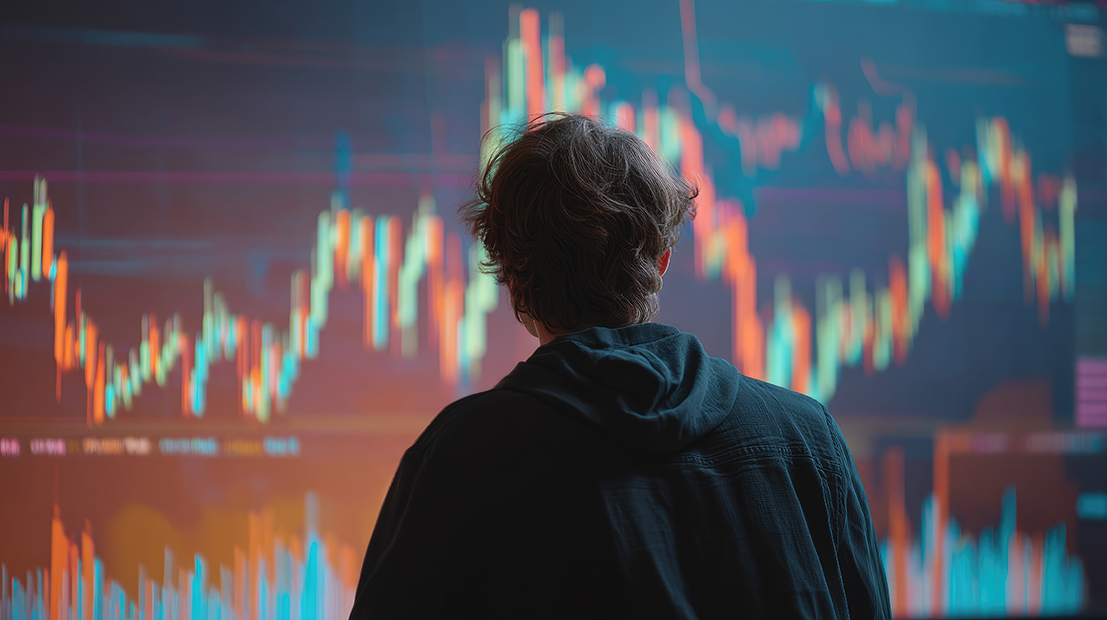

Investors globally and domestically are stuck in this weird holding pattern. We are all clearly waiting for more definitive signals on the direction of tariffs and broader policy settings, and despite US-China trade talks, we would argue this is news for news' sake – it is not fact. This uncertainty is casting a long shadow over the market, but you wouldn’t know it; the recent volatility has all but reversed equity losses.Beneath the surface, several important trends are shaping the outlook, particularly around the movement of prices for both commodities and consumer goods. For example, look at how local retailers respond with their own pricing strategies to deal with the ‘new trade order’. At the same time, expectations around index rebalancing are adding another layer of complexity, with market participants closely watching which companies might move in or out of major indices in the coming months as geopolitics and the digital age move weightings around.Investors are acutely aware that the next major move will likely be dictated by policy announcements, which could come at any moment and in any form, and so are scrutinising every development for clues.First - In this environment, we are very mindful of oil, any second-order effects that lower oil prices as a traded commodity and at the petrol pump, could have on the broader economy for Australia and, by extension, our China-linked economy. A deal between the US and China, but also Russia and Ukraine, would be huge for oil.Second, there is also an ongoing debate about whether the Australian economy and local equity markets will see any real benefit from a period of goods disinflation, or whether the impact will be more limited than some expect.Looking ahead to the June 2025 index review, expectations are that the level of change will be more subdued compared to what was seen in March. The most significant adjustment on the horizon is the likely addition of REA Group to the S&P/ASX 50 Index, replacing Pilbara Metals. Beyond that, Viva Energy is currently positioned within the 100–200 range and could move up if conditions are right, while Nick Scali is well placed to enter the 200 should a spot become available, and in a rate-cutting environment, consumer discretionary is going to be interesting. The June rebalance is due to be announced on June 6 and implemented on June 20, so there’s plenty of anticipation building as investors position themselves ahead of these changes.Zooming out to the macroeconomic front, several catalysts are likely to shape the market narrative in the weeks ahead.Consumer and business sentiment, first-quarter wage growth, and the April labour force data are all in sharp focus this week and next. The expectation is that consumer sentiment will have continued to decline in May, extending the broader deterioration that’s been in place since the US tariff announcements. Business surveys for April show that both confidence and conditions are holding steady, tracking above their long-run averages.Turning to Wednesdays, Wage index growth is expected to have accelerated in the first quarter, with forecasts pointing to a 0.8% increase quarter-on-quarter and a 3.9% rise year-on-year. This acceleration is being driven by a combination of ongoing tightness in the labour market, stronger enterprise bargaining agreements, and legislated increases in childcare wages.Thursday’s labour force data for April is expected to show 40,000 jobs added, with the unemployment rate holding steady at 4.1%. A slight uptick in participation to 66.9% is also anticipated, reflecting the ongoing strength of the jobs market.In the housing sector, the latest data is less encouraging. Building approvals fell by 8.8% in March, with a 13.4% drop in house approvals. These figures are weaker than both market and consensus expectations, and the annualised rate has now fallen to 160,000. This points to ongoing challenges in the construction sector and raises questions about the sustainability of the housing market recovery. This will bring the RBA and the newly elected Federal government into sharp focus – action is needed, but what that looks like is hard to define.Commodities markets have also seen significant movement, with oil prices dropping below US$60 per barrel, the lowest point since early 2021. This has brought OPEC into sharp focus. The crux question is whether OPEC will attempt to chase prices lower or instead move to stabilise the market. So far, they have pushed prices with deliberate oversupply to punish certain nations – this, however, is unsustainable and will have to change soonCouple this with weaker demand from Asia, and a volatile US dollar is also playing a role, with Brent crude now trading at $55 per barrel. These developments are feeding into broader concerns about global growth and the outlook for commodity exporters.Looking at the local currency and AUD has shown remarkable resilience, supported by a meaningful improvement in the country’s energy trade balance and a weaker US dollar. However, the next major test for the currency will come with the release of the US CPI data on Wednesday, which could set the tone for global markets in the near term – is the Fed out of the market in 2025? This will impact the USD.Looking at the globe, the market and financial landscape is still navigating a complex web of challenges, with persistent inflation, potential tariff implementations, and evolving economic dynamics all in play.Market participants are increasingly focused on how these factors interact and influence everything from consumer pricing to investment strategies. Central bank decisions, especially from the Federal Reserve, have been pivotal in moderating market sentiment, while ongoing discussions about trade policy continue to reshape the global economic environment. Tariffs, in particular, are forcing companies to rethink their supply chains. You only must look at the US reporting season and the likes of Ford, GM, Nike and the like, all scrapping forward guidance and highlighting the impact tariffs are having on cost. The second event that is now becoming ‘actual is that the higher input costs are often now being passed on to consumers. The broader issue here is that this can reduce household disposable income and slow broader economic growth.So, although the excitement of early April has subsided, it's only a social media release away. That means that we as investors are navigating a period of heightened uncertainty, with every policy announcement, economic data release, and market move being scrutinised harder than normal as we look for what it might signal about the path ahead.The interplay between inflation, tariffs, and shifting economic dynamics means that flexibility and vigilance will be essential for anyone looking to make sense of the current environment and position themselves for what comes next.


IntroductionSo, what is a Trading Edge?There is much written and many videos on social media that are out there singing the praises of developing a trading edge, and why it is a must if you want trading success, BUY in terms of practical “how do a get one” advice, most that is written seems to fall short of something substantive that you as a trader can work with.When you read articles discussing the concept of an "edge," they're talking about having some kind of advantage over other market participants; after all, there are always winners and losers in every trade.However, many traders are often mistakenly informed that edge relates solely to a system, but the reality is that it encompasses so much more than that. While systems certainly matter, your edge also includes how you think, act, and execute under pressure when YOUR real money is on the line.Your advantage may stem from speed, knowledge, technology, or experience, or better still a combination of all of these, the key point here is that you're not trading like so many others without the appropriate things in place and the consistency that is required when trading any asset class, on any timeframe to achieve on-going positive outcomes.Here's something worth considering before we have a deeper dive into your SEVEN secrets. Simply having a plan, trading it consistently, and evaluating it regularly gives you an advantage over more than 75% of traders out there. Most market participants lack these basic but critical elements of good trading practice. Just doing these fundamental things already puts you ahead of most, but refining further will truly set you apart from the crowd.At its core, a trading edge can be defined as a consistent, testable advantage that improves your odds over time. It's not about achieving perfection but developing repeatability in results and establishing statistically positive, i.e. evidence-based action that will work in your favour.So, despite what you may have seen or heard previously, a complete edge combines idea generation, timing, risk management, and execution; it's not just about focusing on high probability entries. It's a whole process, not a single isolated rule or signal.Just to give an example, a trading system that wins only 48% of the time may not seem that impressive on the surface to many, but if it consistently delivers a 2.5:1 reward-to-risk ratio can still achieve long-term profitability. The key issue in this example is the combination of numbers that creates the result, AND the word consistently.That IS an edge.In this article, we will explore SIX things that are not so regularly talked about in combination, this is the difference, and an approach that can move you towards creating such an edge.As we move through each of these, use this as your trading checklist for potentially taking action on the things that you need to take to the next level, and so take affirmative steps to sharpen your edge.Secret #1: An Edge Is Something You Build, Not Something You FindAs traders, we are always looking for the “holy grail”, that system or indicator that means we will be a success. As previously discussed, that is NOT what constitutes an edge. We need to let go of the idea that there's something magical waiting to be discovered and get to work on the things we need to.Your edge comes from testing, refining, and aligning strategies with your personal strengths and market access. The best edges are customised to your specific goals and circumstances, not simply downloaded from someone else's playbook, you may have heard on a webinar, conference or TikTok post.Your strategies should be a natural fit with your daily routine, available tools, trading purposes, and emotional style. If your approach you choose clashes with your lifestyle, mindset or experience, your execution and results will invariably suffer when you are in the heat of the market action and have decisions to make. For example, if you are a trader working a full-time job, it may be wise to either build a 4-hour chart trend model that matches your limited availability, consider some form of automation or restrict yourself to small windows of opportunity on very short timeframes for times that you can ringfence.We often come across systems that look attractive on the surface. When you copy others, you might get their trades, but you won't have their conviction (belief in your trading system is critical in terms of execution discipline) or context, e.g., their access to markets, and so you will find that you won't match their published results.Without the required deeper understanding of why a strategy works, you'll struggle to stick with it through the inevitable trades that don’t go your way, and drawdowns that WILL always test your resolve to keep with any system.So, the key takeaway is that you must make the investment in time, in yourself as a trader and do the work as you move towards building your edge. There are no shortcuts!Secret #2: Probability of Your Edge Is Only as Good as Your DataData that you can use in your decision-making for system development and refinement can come from accessing historical test data, but more importantly, YOUR results in live market trading (whether from journaling or automated tracking).The strength of this in developing an edge depends directly on two key things.Firstly, on data being clean, i.e. the key numbers relating to what happened, and sufficient detail with a sufficient critical mass of results that allows you to see beyond the profit/loss of a handful of trades. The meticulous recording to a high quality of this evidence makes it a priority if you are to create something meaningful on which to base decisions.Poor data creates false confidence in any system developed on such with fragile strategy and forces you to rely on guesswork to fill in any gaps or because you simply haven’t got enough numbers on which to make a strategic decision.Think about this for a moment, if you have 60 trades, across three strategies, and then of those 20 trades per strategy, 10 are FX and 10 are stock CFDS, and of those 10, 5 are long and 5 are short trades, to make substantive decisions on 5 trades hardly seems like enough evidence on which to base something so important. To think that this is ok, go full tilt into the market, your confidence based on a sample so small, there is a high chance your strategy will likely break under real market pressure.Always ensure the market conditions in your testing environment reasonably match your live trading environment.Even when using backtests to try to get more evidence, which on the surface seems worthwhile, it is not without pitfalls unless due care is taken. For example, back tests performed exclusively during trending market periods won't adequately prepare your system for range-bound price action.Secret #3: Simplicity May Beat Complexity Under PressureSimple systems prove easier to create, allow you to find errors when they are occurring, and of course follow in the heat of inevitably volatile market moments. The more clarity you have about exactly what to do and when, significantly reduces hesitation and increases follow-through when decisive trading action may matter most.A complex system, as a contrast, increases your “thinking load”, slows your reaction time when speed of decision may count, and if you have 14 criteria to tick before action, may lead to the “that’s close enough” temptation for trade actions. Adding more indicators without evidence rarely does anything but make your charts look more impressive and typically leads to more doubt and “short-cutting” rather than better results.As a formula, more rules = more system and trader fragility, which is potentially a good rule of thumb to have in place.Consider how some automation, for example, the use of exit-only EAS, can help simplify the execution of otherwise complex situations and achieve consistency.It is not inconceivable that a trader using a simple price-only breakout strategy consistently outperforms another with a 12-indicator system by executing cleanly during volatile news events when others freeze with so-called “analysis paralysis”.Secret #4: Edge Disappears Without Execution DisciplineYou could have the most brilliant, robustly tested, evidence-based strategy on the planet and yet the reality of why many traders fail to reach their potential is at the point of action. Plans are often skipped, rushed, or mismanaged, and the harsh reality is that your system of systems that you have invested a considerable amount of effort and time to develop may crumble without precise, consistent and disciplined execution.Emotional interference in decision making is something we discuss regularly at education sessions, whether from fear of loss, greed, revenge trading or the fear of missing out on potential profit, can kill performance, even when presented with textbook setups and times when price action is telling you it is time to get out. Even momentary lapses in judgment and actions originating from cognitive biases can undo hours or days of careful preparation or remove the profit from several previous trades.Recency bias can creep in quickly, even after a couple of losses, where hesitation in action in an attempt to avoid the same again costs you the opportunity that the “plan-following” trade can give you.What brings your edge to life is consistency in action, not just having a good plan. The discipline of follow-through can transform a considered and carefully developed system into actual profits, and quite simply, to fail to do this is unlikely to deliver the results you seek.Secret #5: Evolve or Expire — Markets Consistently Change, So Should YouMarket circumstances, fundamental drivers and shifts in these create different conditions not only in price action and direction, but volatility and effects in sentiment can be changed for the long term, not just the next hour. If markets evolve to a new way of acting, it is logical that your systems must, at a minimum, be able to accommodate this. This is part of your potential edge that few traders master (or even look at!), but your systems must evolve accordingly when markets change. What works brilliantly in the last few months may not necessarily work forever—diligently monitor changes and adjust your approach.Static systems will potentially degrade in outcomes without regular review and adaptation, or at best have significant periods of underperformance. Perhaps think of your strategy as requiring a review and maintenance plan like any sophisticated machine.In practical terms, system evolution means identifying when strategies do well and not so well, including evaluation of performance in different market conditions. With this information, you can make informed changes based on evidence, not random tinkering or looking for the next new indicator to add.Remember, you always have the ultimate sanction of switching a strategy off completely during specific market conditions that may mean risk is increased.Secret #6: Effective Risk Management Is an Edge MultiplierIt is difficult when talking about a multi-factor approach to hone down on the most influential factor, but this may be it.Your position sizing approach in not only single but multiple trades determines whether your edge, even when followed to the letter, can scale profitably or self-destruct dramatically. The same system can either give you ongoing positive outcomes or destroy an account based depending on how you size your positions.Risk too much, and you'll potentially blow your account up; risk too little, and you'll generate gains that make little difference to the choice you can make with any trading success.Your sizing should align with both your system's statistical properties as we discussed before and your psychological comfort zone, as the latter is equally something that will develop over time with sufficient belief in your system – a key factor as we have discussed at length in other articles, in the ability to be disciplined in trade execution.Only scale your position sizing after accumulating a critical mass of trades and establishing a clear set of rules based on a record of positive trading metrics for doing so. Premature scaling should only be done when you have proved not only that your system looks as though it performed favourably but also that you have the consistency to move to the next level.Finally on this point, and perhaps the topic of a future article in more detail, concerning the previous point relating to market conditions, once you have developed a way of identifying market conditions and fine tune strategies accordingly, there is of course the possibility of using this information to position size more effectively, To give a simple example something like market condition A =1% risk, market condition B = 2% risk.Summary and Your Actions...As stated earlier, a good approach to this article is to use it as a checklist. Invest some time to review the material covered here and make a judgment of where you are right now with some of the things covered.For some of you, there may be a few things to work on; for others, it may be just some checking and fine-tuning. Either way, identify at least one specific area to work on immediately. One insight that you implement properly is worth far more in terms of the difference it can make than a few insights you just acknowledge but forget to take action on.Ask yourself honestly: "On a scale of 1-10, how do I perform on each of the above in the pursuit of my current trading edge?Or perhaps where would I like it to be six months from now?"Build yourself a roadmap to achieve these, and of course, commit to and follow through in making it happen.

